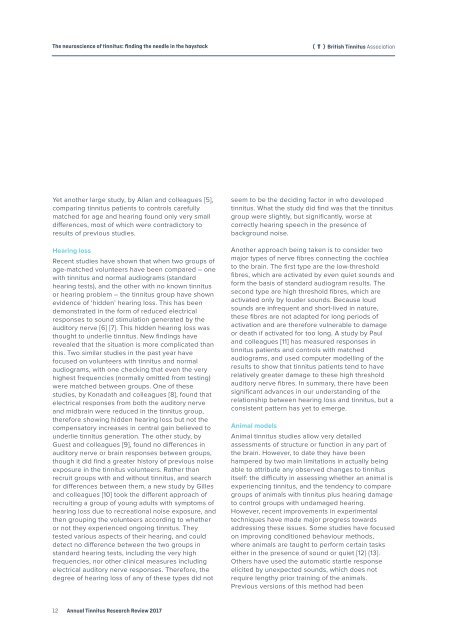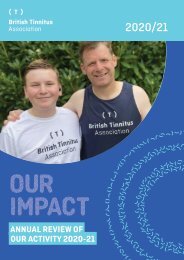The Neuroscience of Tinnitus
You also want an ePaper? Increase the reach of your titles
YUMPU automatically turns print PDFs into web optimized ePapers that Google loves.
<strong>The</strong> neuroscience <strong>of</strong> tinnitus: finding the needle in the haystack T British <strong>Tinnitus</strong> Association<br />
Yet another large study, by Allan and colleagues [5],<br />
comparing tinnitus patients to controls carefully<br />
matched for age and hearing found only very small<br />
differences, most <strong>of</strong> which were contradictory to<br />
results <strong>of</strong> previous studies.<br />
Hearing loss<br />
Recent studies have shown that when two groups <strong>of</strong><br />
age-matched volunteers have been compared – one<br />
with tinnitus and normal audiograms (standard<br />
hearing tests), and the other with no known tinnitus<br />
or hearing problem – the tinnitus group have shown<br />
evidence <strong>of</strong> ‘hidden’ hearing loss. This has been<br />
demonstrated in the form <strong>of</strong> reduced electrical<br />
responses to sound stimulation generated by the<br />
auditory nerve [6] [7]. This hidden hearing loss was<br />
thought to underlie tinnitus. New findings have<br />
revealed that the situation is more complicated than<br />
this. Two similar studies in the past year have<br />
focused on volunteers with tinnitus and normal<br />
audiograms, with one checking that even the very<br />
highest frequencies (normally omitted from testing)<br />
were matched between groups. One <strong>of</strong> these<br />
studies, by Konadath and colleagues [8], found that<br />
electrical responses from both the auditory nerve<br />
and midbrain were reduced in the tinnitus group,<br />
therefore showing hidden hearing loss but not the<br />
compensatory increases in central gain believed to<br />
underlie tinnitus generation. <strong>The</strong> other study, by<br />
Guest and colleagues [9], found no differences in<br />
auditory nerve or brain responses between groups,<br />
though it did find a greater history <strong>of</strong> previous noise<br />
exposure in the tinnitus volunteers. Rather than<br />
recruit groups with and without tinnitus, and search<br />
for differences between them, a new study by Gilles<br />
and colleagues [10] took the different approach <strong>of</strong><br />
recruiting a group <strong>of</strong> young adults with symptoms <strong>of</strong><br />
hearing loss due to recreational noise exposure, and<br />
then grouping the volunteers according to whether<br />
or not they experienced ongoing tinnitus. <strong>The</strong>y<br />
tested various aspects <strong>of</strong> their hearing, and could<br />
detect no difference between the two groups in<br />
standard hearing tests, including the very high<br />
frequencies, nor other clinical measures including<br />
electrical auditory nerve responses. <strong>The</strong>refore, the<br />
degree <strong>of</strong> hearing loss <strong>of</strong> any <strong>of</strong> these types did not<br />
seem to be the deciding factor in who developed<br />
tinnitus. What the study did find was that the tinnitus<br />
group were slightly, but significantly, worse at<br />
correctly hearing speech in the presence <strong>of</strong><br />
background noise.<br />
Another approach being taken is to consider two<br />
major types <strong>of</strong> nerve fibres connecting the cochlea<br />
to the brain. <strong>The</strong> first type are the low-threshold<br />
fibres, which are activated by even quiet sounds and<br />
form the basis <strong>of</strong> standard audiogram results. <strong>The</strong><br />
second type are high threshold fibres, which are<br />
activated only by louder sounds. Because loud<br />
sounds are infrequent and short-lived in nature,<br />
these fibres are not adapted for long periods <strong>of</strong><br />
activation and are therefore vulnerable to damage<br />
or death if activated for too long. A study by Paul<br />
and colleagues [11] has measured responses in<br />
tinnitus patients and controls with matched<br />
audiograms, and used computer modelling <strong>of</strong> the<br />
results to show that tinnitus patients tend to have<br />
relatively greater damage to these high threshold<br />
auditory nerve fibres. In summary, there have been<br />
significant advances in our understanding <strong>of</strong> the<br />
relationship between hearing loss and tinnitus, but a<br />
consistent pattern has yet to emerge.<br />
Animal models<br />
Animal tinnitus studies allow very detailed<br />
assessments <strong>of</strong> structure or function in any part <strong>of</strong><br />
the brain. However, to date they have been<br />
hampered by two main limitations in actually being<br />
able to attribute any observed changes to tinnitus<br />
itself: the difficulty in assessing whether an animal is<br />
experiencing tinnitus, and the tendency to compare<br />
groups <strong>of</strong> animals with tinnitus plus hearing damage<br />
to control groups with undamaged hearing.<br />
However, recent improvements in experimental<br />
techniques have made major progress towards<br />
addressing these issues. Some studies have focused<br />
on improving conditioned behaviour methods,<br />
where animals are taught to perform certain tasks<br />
either in the presence <strong>of</strong> sound or quiet [12} {13].<br />
Others have used the automatic startle response<br />
elicited by unexpected sounds, which does not<br />
require lengthy prior training <strong>of</strong> the animals.<br />
Previous versions <strong>of</strong> this method had been<br />
12<br />
Annual <strong>Tinnitus</strong> Research Review 2017


















